Background
My inspiration for this project comes from Simply Simon's Let's Play Mega Man series of well, Let's Plays. He took a more analytical look at the series and how it develops over time compared to most LPs which just show off how to beat the robot masters with just the buster or whatever.
At some point in the thread somebody linked a similar project, though in screenshots known as http://telebunny.net/talkingtime/showthread.php?t=12539">"A Critical Look At Mega Man Stages" which has been going on for quite some time now covering everything as well.
This got me inspired (months ago) to try something similar with ZZT games. See what they did, try to deduce why, and figure out if it was a good or bad design decision in the end. I'll be starting with Town of ZZT by virtue of being the first game.
Updates
I do not know how much I will play. I'm sure I can force my way through Town, and if I and others remain interested take a look at the other original worlds or any other games really. For Town each update will be retrieving one purple key and unlocking its door. Other games should I play through them may have different stopping points.
The Setup
Unfortunately, in the year 2012 ZZT is much more difficult to run. I have opted to play in Dosbox rather than using Lyon for accuracy's sake (though Lyon from what I've seen is quite capable). Originally I began playing with a PS2 controller and joy2key to map buttons to keys. Alas Dosbox doesn't seem to like this and I found myself unable to shoot. So instead I'm doing the standard keyboard controls. As a child I used to use my left hand on right shift to shoot though these days the left shift seems more natural for this.
The downside of running in Dosbox is its known issue with it not cooperating with ZZT's input detection. There's a clear lag between holding a key and moving and holding one direction then switching to another causes a full stop. This does put me at a disadvantage as you are generally fairly maneuverable running ZZT natively.
The Audience
Though I am posting this on http://zzt.org">z2 first and foremost. It's pretty much dead. These entries will also be crossposted to http://videogame-tales.livejournal.com/">Video Game Tales a livejournal community where there's a slightly larger audience. I will generally try to explain things to new viewers so they can have a better understanding.
With all that stated, Let's Begin Analyzing ZZT!
Town of ZZT
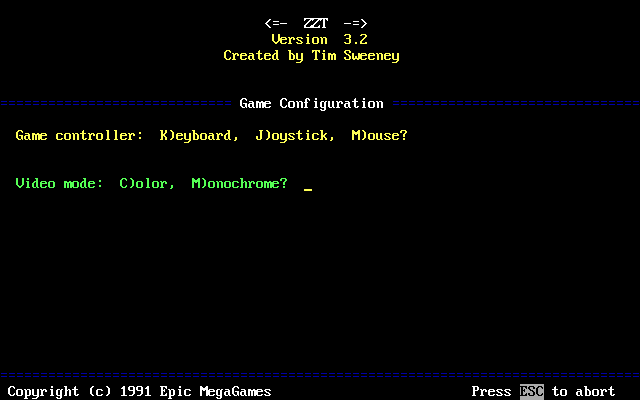
Before we can even begin to choose our world we are greeted with the standard options which ZZT will ask us time and time again. Our input, and our monitor type. Mouse controls are very unwieldy for a tile based game, and in 1991 I believe joysticks were generally flight sticks which don't strike me as much better. In 1991 I'm sure somebody was stuck with an amber monitor forced to play nothing but ASCII games, but choosing monochrome graphics didn't seem to help much. Keys all appear white which strikes me as a bit cruel.
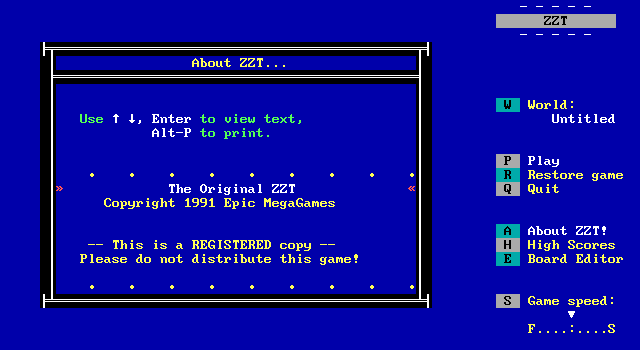
Next we are greeted with a reminder telling us not to copy that floppy. Only Town, Demo, and Tour were shareware and could be provided to others. For reference, the order form for the game says that registration is $12.95. Registering gave you a registered copy of ZZT, a hint sheet, and Caves of ZZT. Surprisingly, The Dungeons of ZZT and Underground City of ZZT were not included by default each costing $6 or $10 for both, or $12 for both plus Best of ZZT. That's rather pricy if you ask me. Also yuck, giving out Caves as the bonus is probably a good way to ensure people don't dare pay for City or Dungeons.

Finally loading the actual game we're greeting with our title screen. All things considered it does a nice job giving you an idea of what you'll find. The others box contains four objects which do nothing, and a bear (which also does nothing). Whether the ruffian object was made an object so it wouldn't move is a likely possibility. The green snake and yellow nameless object are not actually found in the game. They may be cut content either for Town or for ZZT in general as snakes are in Super ZZT and in the editor the unprogrammed dragon pup enemy uses a phi symbol.
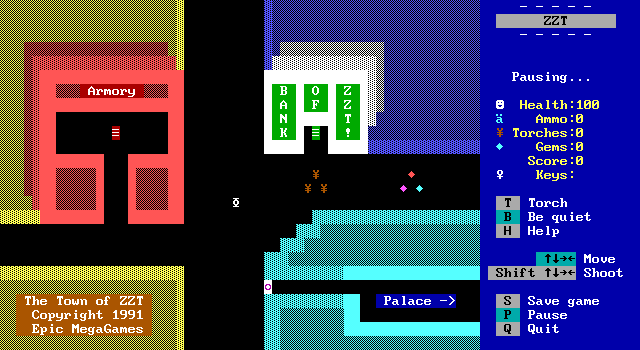
Finally we get to the actual game. Town gives us the opportunity to explore however we like. Most ZZT games later on would eschew this nonlinear gameplay as stories become more prevalent. The open world is a plus as this gives the player the chance to try something else if they find something too difficult in their first encounter.
As far as choices in ZZT go, this is a massive amount. There are six immediately accessible paths and at first glance a seventh opens up when we get our first purple key. The scroll (an object so you can reread if needed) gives you all the plot you're going to get: Find the five purple keys to get into the palace. Health and how to save are also covered.
A new player may choose any of these directions to go. For the sake of easily managed updates I'll be heading into the armory first, and then going east. East was chosen by asking somebody with zero context which path to take.
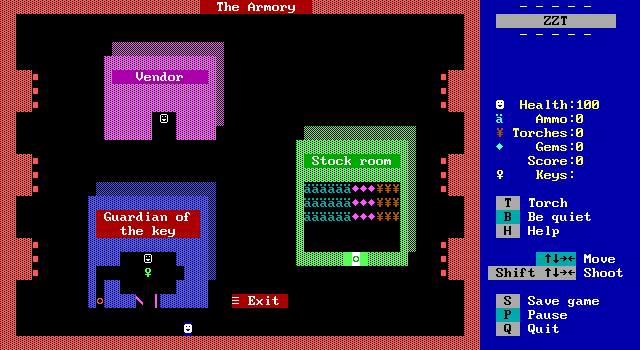
The Armory, is likely a logical first destination when the player sees they have zero ammo to start. The vendor sells 3 ammo or one torch for a gem. He also offers "advice" which Tim Sweeney believed meant "Stairway to Heaven lyrics". To his credit, every time I hear that quoted verse I think of ZZT. I doubt I'm the only one as somebody even made a game in tribute to Sweeney known as https://museumofzzt.com/file/f/forests.zip" target="_blank">The Forests Will Echo With Laughter.
In addition to a shop, we also get our first puzzle. There's lots of supplies in storage and the key is in plain sight. Purple conveyors are introduced to the player here as they fruitlessly try to rush in. Meanwhile the guardian paces back and forth keeping watch over the key. The red object rings the doorbell causing the guardian to move towards it and and answer it.
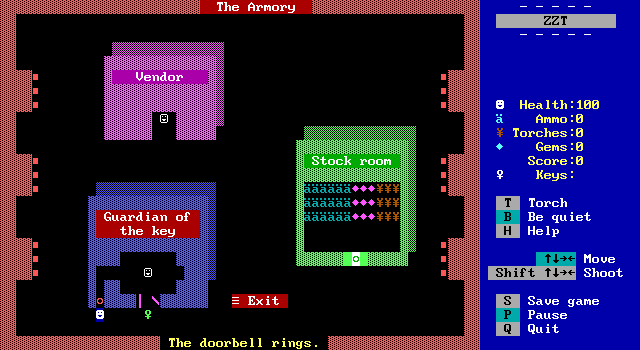
The traditional solution to this puzzle is to ring the doorbell when the guardian is above the key (as in the screenshot) causing him to push it into the conveyors and outside to you. There is in fact one alternate solution that's much more effort but still likely intentional.
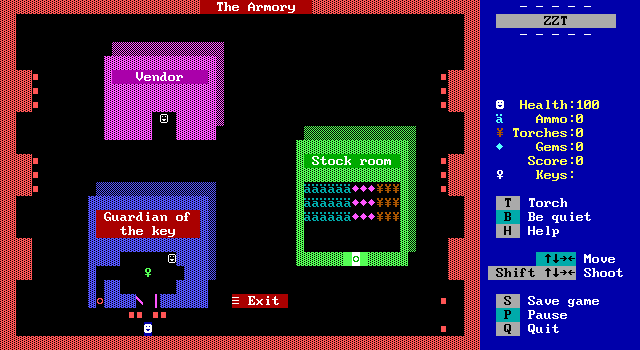
A player aware of boulders can push them and essentially jam the conveyors, allowing the player to run in and grab the key. Ther guardian has no reaction to this and can't be interacted with in any way other than the doorbell where he will call you a cretin.

This is probably my favorite emoticon I added to z2. 1991's equivalent of SA's :getout: frog.
There is a third solution to the puzzle, though it is more of an exploit in ZZT's behavior than an intended method to complete it. When you pause the game, you can move and sometimes pause again before any other object can react. By mashing the up arrow and the pause key it's possible to brute force your way in. This "pause motion" behavior as I've dubbed it can exploit a lot of things in ZZT by allowing the player to move far more than a single step per cycle. A more comical version of this can be done by choosing mouse input and holding down the pause key while moving the mouse. This lets you practically stop time to the point where running into your own bullets is trivial.
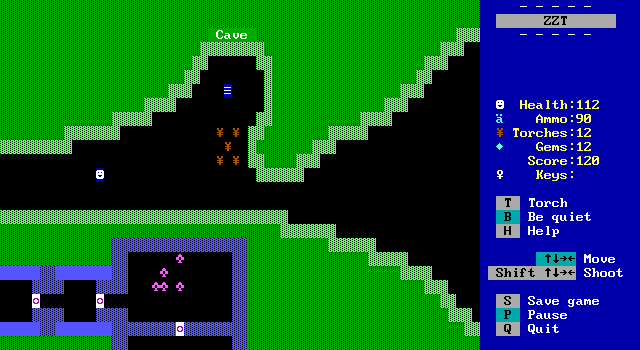
Moving on, my randomly asked person chose east so I set off in that direction. Quite possibly the laziest depiction of a cave ever made is seen here. While I myself know that this is an optional area with little purpose, a new player with the free torches given here would likely check it out right away.
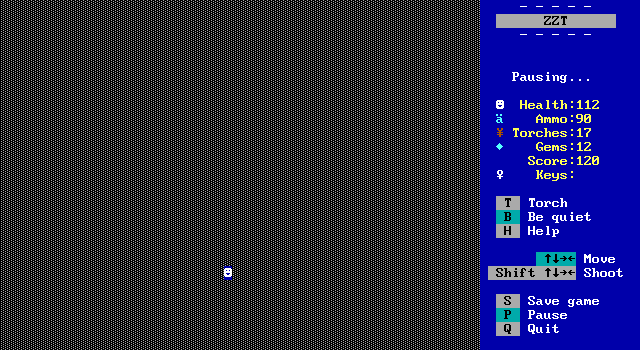
Where they would be greeted with this! Darkness in ZZT is rather dark before you light a torch. Lighting a torch creates a small round area of light around you. In general darkness makes navigation and combat much less fun. For the sake of the audience I also took screenshots of dark boards with the -dark cheat on.
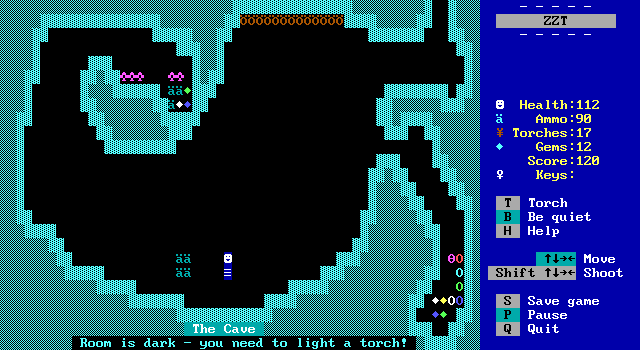
In ZZT cheats are entered by pressing ? and then typing them in. Most cheats just give you items such as "ammo", "gems", "torches", and "health". -dark however is a bit more special as it's actually two cheats. The first, obviously, is to remove the darkness property from the board. However, in addition zzt supports arbitrarily setting and clearing of flags with ?+flag and ?-flag. While most cheating cannot easily be stopped by the author of a game, the fact that -dark also clears the flag dark makes it very easy to detect if a player turned on the lights.
Most games, mercifully would do nothing. Some would have little messages in pockets of the room normally always invisible complaining that you cheated. A select few would instead immediately kill the player if they did this. Zenith Nadir, is one such jerk.
Darkness is typically very very poorly used. For this series I will be playing these boards in darkness with torches as intended. Realistically, the reason darkness is so poorly done is simply torch management. As you can see, the T key lights a torch. This means having one hand leave the shift key to light one when one goes out. In combat situations it is very easy to lose considerable health because of this. It's actually why I tried setting up a custom joystick control scheme.
Now that we can actually see the room, it's fairly empty and safe. Purple ruffians defend a small pocket of ammo and gems, and a centipede runs about in the opposite corner. Bears, which only move when in close enough proximity to the player are up top and it's possible to not even notice them if you hug the walls.
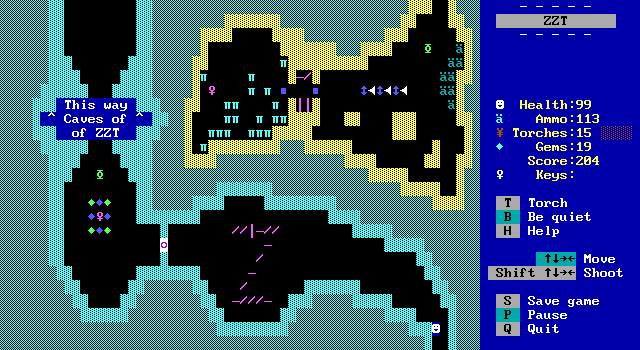
This second room of the cave is also dark. You can see my torch meter on the sidebar showing my torch is about to run out. The room is a dead end, and if you have a purple key you can receive an immediate replacement, some gems, and an ad for Caves of ZZT. The torch's radius is not large enough to let you see that you'll get a new purple key and it is possible somebody would be paranoid of the game entering an unwinnable state if they use their key for the palace on this door. The door could just as easily not have been there saving players a second trip if they did dare use a key just to get a few gems.
All in all the cave is only useful as an introduction to dark rooms. The upper yellow area comes into play later and I will cover it then.
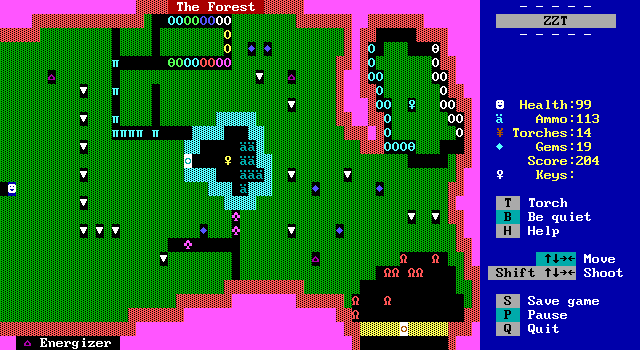
Heading out of the cave and farther to the east we get another safe introduction to things. The Forest, is covered in forest tiles, which block enemy movement, though when a player steps onto such a tile, the tile is removed. This room also introduces us to energizers, ZZT's invulnerability powerup, and pushers, which constantly try to move in the direction they point, crushing gems or enemies in their paths but not harming the player. Energizers last long enough that the player can likely clear out all the enemies other than the avoidable ruffians with the three provided and not have to fire a single shot. At the very least they can get the cyan key and get some ammo if they didn't acquire any elsewhere yet.
The only other thing of note to the behavior of energizers is that enemies will flee from the player when he is invulnerable. This also applies to objects using the #go seek or /seek command.
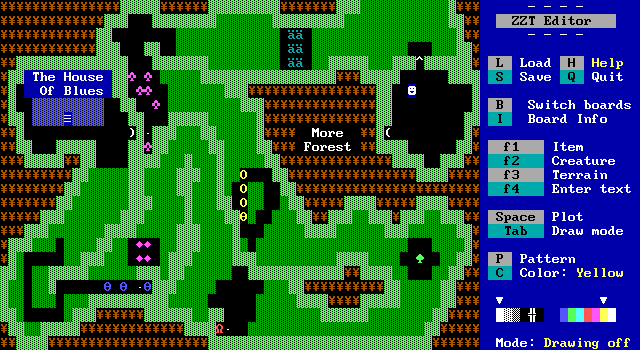
(This screenshot was missing, hence the editor sidebar)
Moving south takes us to the rest of the forest where we get to play around with what can be done with the terain and also are introduced to duplicators. Those small dots you see by each of the enemy types will slowly produce more enemies. The player needs to get past them, but has the luxury of being able to make narrow paths in the forest to flush the enemies into where they can be safely defeated.
Duplicators are oddly buggy in ZZT. If the player were to stand in the tile where duplicated enemies would spawn, instead the original enemy would be destroyed and the player would take damage, thus ending the possibility of more enemies at the cost of 10 health. One could argue this is a deliberate feature, however in games where there are programmed objects being duplicated, nothing happens to the player or the original, but the duplicator will never produce additional copies even if the tile is clear the next time it would try.
The small clearing with the tree offers the player the wise advice to invest in leaves. The white parentheses and carat are transporters, these will offer the player a quick escape on the way out rather than having to fight more enemies. That's all the new stuff.
Artistically, this is a nice board. By default (I guess it's a good thing we have an editor screenshot here), ZZT only supports seven bright colors. Some objects are always one color, while others can be customized. The game does have 16 colors in total, dark variations of the default seven colors, plus two shades of gray. Later on, others would discover ways to get access to all these colors, but that's a story for another time.
In these days, using torches to represent trees was a fairly common thing and it makes a nice backdrop compared to more bright green or some other solid background.
One last thing to mention about all these boards on the eastern path, is that they all limit you to having one bullet on screen at a time. This makes accuracy important and being able to make narrow paths in the forest to ensure a hit makes things easier on the player. The main combat boards here also transport the player back to the last entrance to the room they used when they take damage, again encouraging safe strategies.
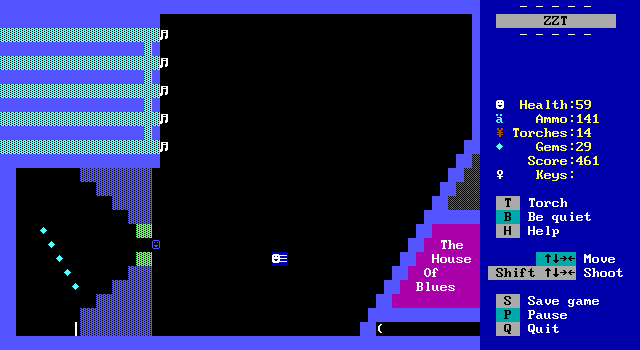
The House Of Blues is our second puzzle. The blue jazz man will sing a song and play a tune over the pc speaker. The player then has to replicate each line of music in the same order on the music notes. Upon doing so the jazz man moves allowing the player to head east. It's another safe puzzle as playing the wrong notes simply resets it. When you play a correct note, its appearance also changes, so once the first note is found the puzzle only gets easier.
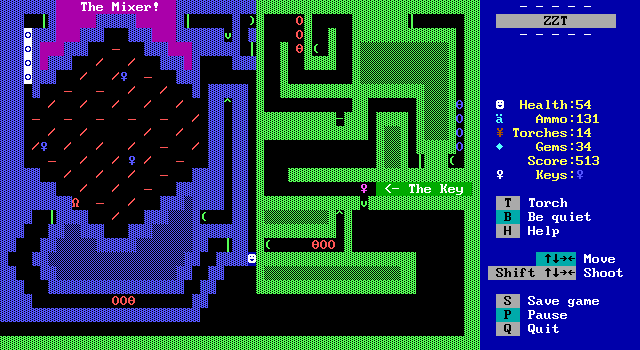
The mixer is where we'll be getting our first purple key, as so prominently displayed. This screenshot wasn't taken immediately on entering the board. Normally there are a few more lions within the mixer. It's rather tedious. Getting hit returns you to the entrance and you can only carry one of each color key so you'll spend a good amount of time trying to shoot the lions and gather and return each key. After making your way through the player can time their trip through the transporters to make sure the centipedes aren't near, and ideally keeping them in narrow corridors where they can't escape the player's bullets. Once you acquire the key you are all set to backtrack to the town's main hub again. The transporter network could've been extended to take you all the way back to town, but instead you'll have to do some walking on likely empty boards. It could have been avoided really. Although, the walk does give the player a chance to get their 8 gems from the cave if they chose.
And that's the end of that!
